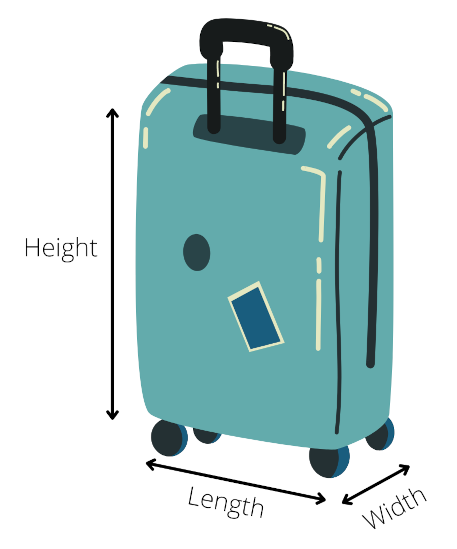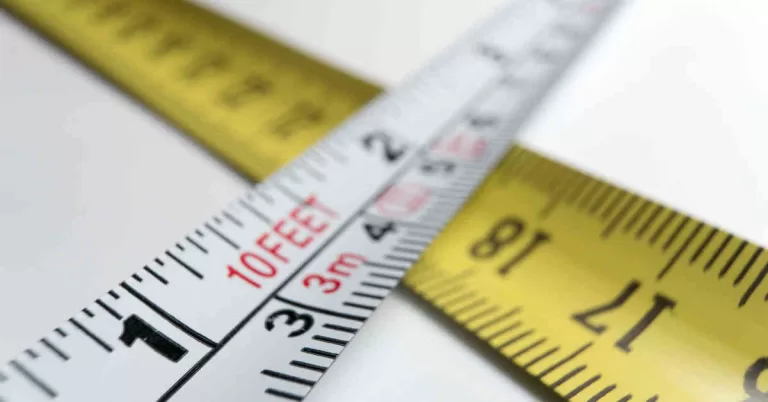Why is it important to know how to measure your luggage? All airlines have rules and restrictions related to baggage. If your bag is larger or heavier than the airline’s limits, you may be subject to hefty fees. Even worse, the airline may refuse to accept your bags at check-in.
Note: We will primarily focus on checked baggage in this post, but much of this information can also be applied to carry-on baggage.
This post will explain how to measure your checked bag, step-by-step. We’ll also offer some options if you don’t have easy access to measuring tools, such as tape measures or a luggage scale.
Caution: When you are shopping for luggage, some retailers make claims such as a particular bag being “carry-on compliant” or approved for use with a specific airline. Be wary of these types of statements. Retailers may be conservative with measurements when it comes to luggage, to sell more products. Be sure to shop with retailers that have a good return policy, in case the piece of luggage does not meet your needs.
Disclosure: Some of the links below are affiliate links. This means that, at zero cost to you, I will earn an affiliate commission if you click through the link and finalize a purchase.
Check Your Airline’s Checked Bag Size and Weight Limits
The first step is to find out what your airline’s standard checked bag size and weight requirements are.
Checked Baggage Standard Size
Almost universally, domestic carriers allow a standard checked bag to be up to 62 linear inches in size (most airlines list a metric equivalent of either 157 or 158 centimeters). Allegiant Air is a notable exception – standard checked bags on this airline can be up to 80 linear inches.
What does “linear inches” mean?
Linear means in one dimension only (in other words, in a straight line). When we measure a bag, we record measurements in all three dimensions (length, width, and height), then add them together. By adding the measurements, we are essentially placing these measurements in a straight line, for a total length of the bag.
The reason airlines declare bag sizes in linear inches is because not all bags are rectangular. Baggage can come in a variety of shapes and sizes. By not having specific maximum length, width, or height measurements, you can check bags such as backpacks or duffel bags without issue.
However, when it comes to carry-on baggage, airlines are stricter with the shape of bags as they need to fit in restrictive spaces – either in the overhead bins or under seats. You will find that carriers will specify maximums for each dimension. This does make sense though – if carry-on baggage did not conform to a rectangular shape, a lot of space in the overhead bins would be wasted.
Checked Baggage Standard Weight
When it comes to standard checked baggage weight, there is disparity among airlines. Most carriers have a 50 pounds (23 kilogram) weight allowance. However, there is a trend among ultra-low-cost airlines to limit a standard checked bag’s weight to 40 pounds (18.1 kilograms).
Tools Required to Measure the Size and Weight of Your Luggage
To measure your bag’s size, you will need a tape measure or a ruler.
To use a tape measure, simply extend the tape out to the length of your luggage and measure from one end to the other.
If you don’t have a tape measure, you can use a ruler instead. Rulers are less user-friendly as a measuring tool though, as they can’t bend to the shape of your luggage. This can result in less exact measurements, especially if you’re traveling with non-rectangular shaped bags.
Tip: Ensure that you are recording your measurements using the proper unit of measurement. Most measuring instruments have one edge with an imperial scale (used in the U.S. – think inches and feet), while the edge on the opposite side has a metric scale (centimeters and meters).
It’s important to measure your luggage before you travel, as airlines have size restrictions for checked luggage. Knowing the dimensions of your luggage will help you figure out if it meets these requirements and avoid any problems when you get to the airport.
In addition to a tape measure or ruler, you may also want to have a luggage scale on hand to weigh your luggage. Luggage scales are easy-to-use and travel friendly. They can help you avoid any extra fees for overweight bags.
How to Measure the Size of Your Luggage
In this section we will explain step-by-step how to measure the size of your baggage.
Gather Your Measuring Instruments
You will need a tape measure or a ruler to measure the length, width, and height of your baggage.
If you don’t access to either of these measuring instruments, there are measuring tape apps available:
- Measure (iPhone / iPad) and Ruler App: Camera Tape Measure (Android)
Please note that apps like these use AR technology, which is only available on late model phones.
To record your measurements, you can use a pen and paper. Alternatively, you can use a note-taking app on your phone to save your measurements. A calculator app will come in handy as some math will be needed to calculate your bag’s size.
Decide on which unit of measurement you want to record your measurements in (either inches or centimeters) and be consistent. It’s best to follow the system of measurement used by your airline. If your measuring tools do not use the same system as your airline, we will explain how to convert your measurements between systems later in this post.
Prepare Your Luggage for Measurement
If you are measuring your bag for an upcoming trip, it should ideally already be packed. A bag’s shape can change after being filled. This will give you more exact measurements.
Some luggage has an expander functionality that can give you more storage space at the cost of a larger bag. If the expander function is not needed, ensure that it is in the compact position. If your suitcase has a retractable handle, make sure that it is indeed retracted.
Once you are ready to begin measuring your luggage, find a suitable flat surface to lay your bag, such as the floor or a table.
Measure the Height of Your Luggage

To measure the height of your baggage, begin by placing it on a flat surface in an upright position, with the longest sides facing up. Use the tape measure or ruler to measure from the bottom of the suitcase (where the wheels are found) all the way to the top end (where the handle is found – make sure it is retracted), making sure to follow the contours of the bag.
You need to include the wheels and handle in your measurements (only because the airlines will…except for Southwest – they omit wheels when measuring your bags), so make sure you start from the bottom of the wheels to the top of any protruding handles.
Record this measurement by either writing it down or typing it in your phone.
Measure the Length of Your Luggage
To measure the length of your bag, place it on its side with the widest part facing up (a similar position to when you’re in bed, sleeping on your side). Use the tape measure or ruler to measure your suitcase vertically, from the surface that it’s laying on to the top, following the contour of the bag.
Record this measurement.
Measure the Width of Your Luggage
To measure the width of your baggage, place the tape measure at the front of the bag and stretch it to the back.
Record the measurement.
Calculate the Size of Your Luggage
Now that you have measured all three dimensions of your bag (length, width, and height), simply add these measurements together to obtain your bag’s size in linear inches (or centimeters).
For example, if the length is 14 inches, the width is 9 inches, and the height is 22 inches, the size of your suitcase would be 22 + 14 + 9 = 45 linear inches.
You can now compare this size to your airline’s size requirements.
How to Weigh Your Luggage at Home
It’s important to weigh your luggage before you travel. If your checked bag is overweight, you may be subject to hefty overweight fees, or your airline may refuse to accept your bag at check-in.
The following instructions apply to all types of luggage: suitcases, duffel bags, backpacks, etc.
Use a Luggage Scale to Weigh Your Luggage
Weighing your baggage with a luggage scale is very easy.
If you have a manual scale (these often look like tiny versions of scales you would commonly find in greengrocers), you attach the scale to your bag, either with a hook or a loop, lift the bag, and note the measurement. Be sure to note the unit of measurement (either pounds or kilograms).
If you are using a digital scale, begin by turning the device on. Make sure that the weight is currently reading zero. If not, reset the weight to zero by referring to the instructions that came with the scale. Ensure that your device is weighing in the desired unit of measurement (again, refer to the scale’s instructions on how to change to the measurement scale needed).
Attach the scale to the bag and lift it off the ground. The digital scale may take a couple of seconds to set to your bag’s weight. Make note of the measurement.
You can then compare the actual weight of your bag to your airline’s baggage weight restrictions.
Use a Bathroom Scale to Weigh Your Luggage
If you don’t have access to a luggage scale to measure your bags, you can use a bathroom scale instead. However, this method may give less exact results.
If your bag can rest on your scale without it overhanging and touching the floor, or toppling over, you can simply record its weight. This method is more suitable for suitcases.
Otherwise, you can weigh your bag indirectly by following these steps:
- Hold your bag and step onto the scale.
- Record the combined weight of you and your bag.
- Reweigh yourself without holding the bag.
- Record your weight.
- Calculate the weight of your bag by subtracting your weight (step 4) from the combined weight (step 2).
Caution: Please check the specifications of your bathroom scale. The combined weight may exceed the scale’s operational weight. You could end up damaging it.
Use a Kitchen Scale to Weigh Your Luggage
Don’t…just don’t.
Household kitchen scales aren’t built to weigh heavy items such as pieces of luggage. Most models can tolerate weights between 10 to 20 pounds only.
How to Convert Measurements to Different Systems
In this section, we will explain how to manually convert measurements from imperial to metric, and vice versa. There are numerous online conversion tools and phone apps that can do the calculations for you as well.
How To Convert from Inches to Centimeters
You may find that you need to convert your measurements from one system of measurement to another. For example, an airline may provide its baggage size restriction in centimeters, but your measuring tape may only be able to measure in inches.
To change from inches to centimeters, you can use the conversion factor that 1 inch is equal to 2.54 centimeters.
So, to convert a measurement that is originally in inches, to centimeters, you can multiply the number of inches by 2.54. For example, to convert 14 inches to centimeters, you would multiply 14 by 2.54 to get 35.56 centimeters.
To make the conversion easier, you can use a calculator or an online conversion tool to complete the conversion for you.
How to Convert from Centimeters to Inches
To convert centimeters to inches, you use the same conversion from the earlier section:
1 inch = 2.54 centimeters
However, to convert from centimeters to inches, you divide the number of centimeters by 2.54.
For example, let’s say you want to convert 10 centimeters to inches. Using the formula above, you would do the following calculation:
10 centimeters / 2.54 = 3.9 inches
So, 10 centimeters is equal to approximately 3.9 inches.
How to Convert from Pounds to Kilograms
To convert from pounds to kilograms, you can use the following conversion:
1 pound = 0.45 kilograms.
Here is an example of how to use this formula to convert 20 pounds to kilograms:
50 pounds x 0.45 kilograms = 22.5 kilograms.
So, 50 pounds is equal to approximately 22.5 kilograms.
How to Convert from Kilograms to Pounds
To convert from kilograms to pounds, you can use the following conversion:
1 kilogram = 2.2 pounds.
To calculate the conversion, simply multiply the number of kilograms by 2.2. For example, if you want to convert 20 kilograms to pounds:
20 kilograms x 2.2 = 44 pounds
So, 20 kilograms is equal to 44 pounds.
Final Thoughts
We hope that you found this post useful. By following the steps outlined above, you can ensure that your luggage meets your airline’s size and weight restrictions. You don’t want to arrive at the airport to pay excess baggage fees for oversized or overweight luggage. Worse yet, your airline may refuse to check your bags if they exceed the carrier’s limits.



